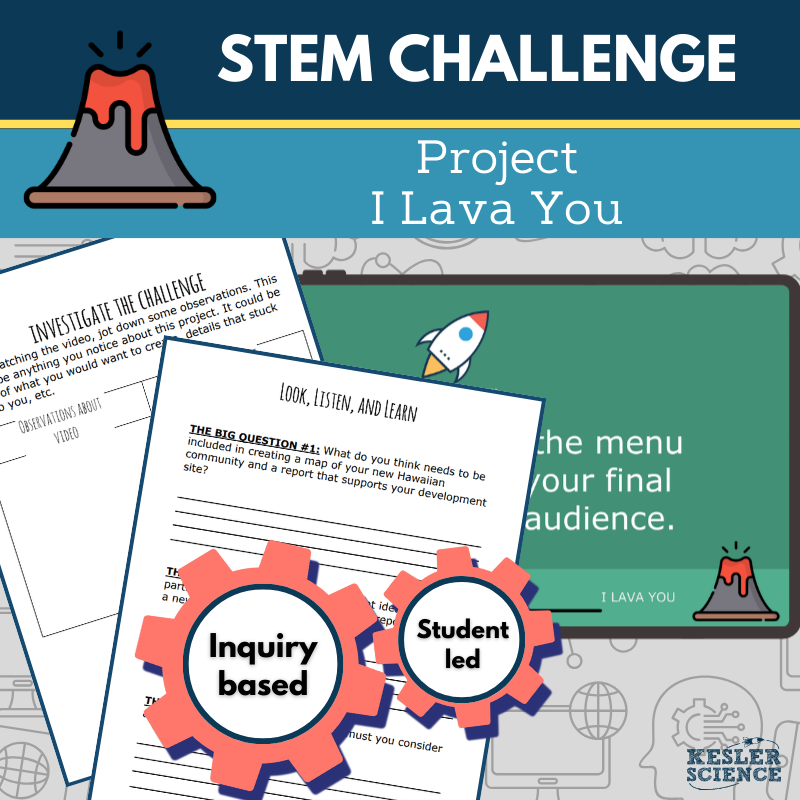
STEM Challenge - Project I Lava You - Rebuild After A Volcano
Looking for a flexible, multi-day activity that gets your students “doing science?” Every STEM Challenge offers a hands-on, inquiry-based, student-led project designed to allow them to step into the roles of researchers and engineers.
STEM Challenge projects are ideal for use at any time throughout the school year, between units, before breaks, or during afternoons when testing weeks occur.
For teachers, there are presentations and step-by-step guides to facilitate pacing and lesson plans that align with standards. Students utilize the included notebooks to guide them through activities (both individually and in small groups), challenge them to learn new information, and reflect on and apply the information they have learned.
The Challenge:
In 2018, Kilauea erupted on the Big Island of Hawai’i. Due to the lava flows, many residents were displaced from their homes. Although discouraged, most people want to remain in the immediate area. You are a home developer on the Big Island and are anxious to build a new community for these families. You will need to study the history and past eruptions to help you predict a good location for new homes. Along the way, you will discover information about how the Hawaiian Islands were formed, what makes them unique, and what their future holds. In order for your development to get approved, you will need to create a map of the local area and a report that supports your build site. These families are counting on you!
What’s in a STEM Challenge?
- a video explaining the engineering challenge and setting the context for the project
- a BIG Question to guide the inquiry
- teacher presentation in PPT (Google-compatible) and Keynote
- a teacher's guide on what the teacher and students should be doing along the way
- student notebook offers
- questions to provide the students with a framework for their inquiry throughout the entire project
- opportunities to absorb new information and reflect on ways to use it to complete the challenge
- Using the LAUNCH process, students brainstorm with their peers and reflect on failures and opportunities, with the prospect of sharing their ideas with the world. This holds students accountable, and they will put forth the best effort, knowing that other students could critique the project.
- Each STEM Challenge contains a list of suggested supplies for its project. We were very cautious about choosing inexpensive items, and the supply list is dynamic, allowing for adjustments to individual situations. Suggested supplies include:
- Cardboard or poster board
- Glue
- Scissors
- Paper
- Tape
- Colored pencils
- Computer
Supports Next Generation Science Standards:
MS-ESS2-2
Construct an explanation based on evidence for how geoscience processes have changed Earth’s surface at varying time and spatial scales.
MS-ESS3-2
Analyze and interpret data on natural hazards to forecast future catastrophic events and inform the development of technologies to mitigate their effects.
MS-ETS1-2
Evaluate competing design solutions using a systematic process to determine how well they meet the criteria and constraints of the problem.
MS-ETS1-3
Analyze data from tests to determine similarities and differences among several design solutions to identify the best characteristics of each that can be combined into a new solution to better meet the criteria for success.
MS-ETS1-4
Develop a model to generate data for iterative testing and modification of a proposed object, tool, or process such that an optimal design can be achieved.
Pickup currently not available
Terms of Use
Copyright © Kesler Science, LLC. All rights reserved by the author. This product is to be used by the original downloader only. Copying for more than one teacher, classroom, department, school, or school system is prohibited. Permission is never granted to enter Kesler Science materials into any form of AI for any purpose. This product may not be distributed or displayed digitally for public view. Failure to comply is
copyright infringement and a violation of the Digital Millennium Copyright Act (DMCA). Clipart and elements found in this PDF are
copyrighted and cannot be extracted and used outside of this file without permission or license. Intended for classroom and personal use ONLY. Multiple licenses are available for purchase by departments,
schools, or school districts. Contact support@keslerscience.com for more information.









